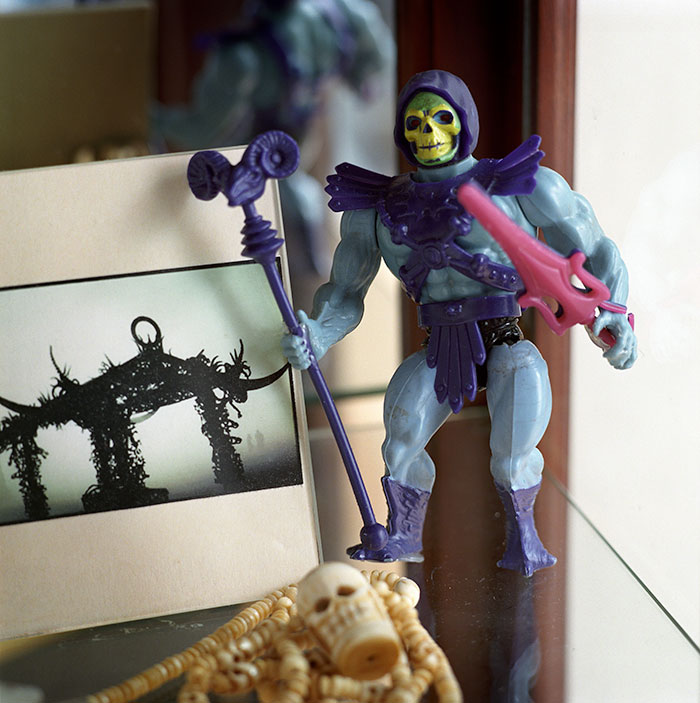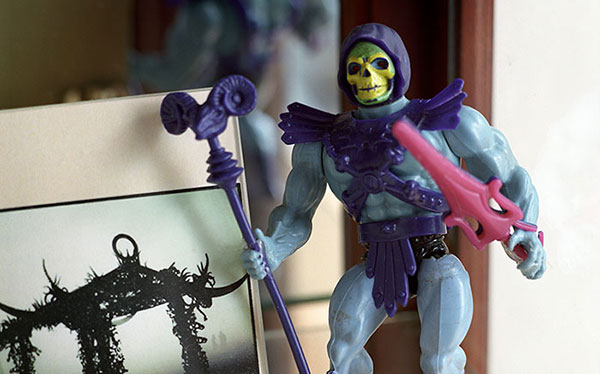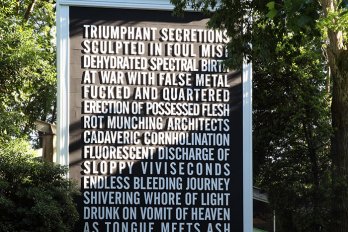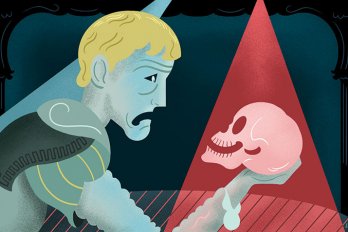Sam grew up in an Alberta hamlet, a place of no consequence to anyone but those fortunate enough to have been born there. The kind of place where you raise two fingers off the steering wheel in greeting when you pass another car on the road.
Sam was a good kid, though a hurting one. He had journals filled with dark confessions. He had legs covered with scars from the time a pot of boiling water had spilled onto his three-year-old body. He was also gay and needed to get to a city. By his twenty-eighth birthday, having rolled through a few towns already, he found himself in Vancouver and searching for love. One night in October 2001, he let a man inside him for ten seconds before muttering, “Hey, you should probably put on a condom.”
Symptoms showed up almost immediately. Sam’s hands and feet became swollen. His tongue got itchy. His glands ballooned. There was dandruff in his golden brown eyebrows. He flipped through a book called The New Joy of Gay Sex and learned that after HIV enters your body, there are seven typical symptoms. He had all seven. For the next eight months, he sat with his self-diagnosis, unwilling to get tested. When he finally went to the clinic on Davie Street, a nurse gave him his results and said, “Do you need a hug? ”
“Yes,” said Sam. Then he walked out into the afternoon, found a park and lay down in the grass. He stayed there for a few minutes and just thought, “Huh.”
He cried only once, the following day, when he thought about telling his parents. But he knew by the time he had wiped his eyes dry that he couldn’t. At a certain point, he said to himself, you have to become a caretaker to your mom and dad, and this would hurt them too much. (Several names have been changed in this story, all because of mothers who don’t know their children are HIV positive.)
Sam didn’t think of his diagnosis as a death sentence the way he would have just a decade earlier. Thanks to the miraculous drug cocktails that appeared in 1996, HIV-positive people now live only slightly shortened lives; the disease is more a chronic condition than a plague. For years, though, he felt like a sexual leper, as if poison ran through his veins. (Which, in a sense, it did; like many others, Sam chose not to start a drug regimen until it became necessary.) His doctor monitored his weakening immune system by counting down a type of white blood cells called T cells. Sam adjusted to being one of the estimated 65,000 people in Canada who live with HIV.
And then something in his body swung wildly off course. Though his T cell count was still high enough that his doctors didn’t feel he needed drugs, Sam’s body wasn’t in agreement. He lost weight and couldn’t stay on his feet for the eight hours necessary to hold down his job in retail. Finally, baffled, the doctors admitted him to Ward 10-C (the HIV ward) at St. Paul’s Hospital, where he would languish in bed for the next month. But the meds the doctors prescribed didn’t cure the mystery ailment, so they started testing. While he lay there, Sam kept a score sheet, a page in his journal full of ticks like the ones cartoon inmates scratch into prison walls. He was counting the number of doctors that had inspected him (twenty-one) and the number of times they had taken his blood (seventy-two).
While the search stalled, Sam learned that, back in Alberta, his cancer-ridden father was in hospital, too. “My dad’s on his deathbed,” he told his friends when they came by with armloads of comic books. “Mom wants me to come home.”
“You have to tell them why you can’t come,” they said.
Before he could decide whether to inform his parents about his status, the doctors gave him more bad news. His weakened immune system had left him vulnerable to an extremely rare (and often incurable) disorder called Castleman’s disease. He was developing lymphoma and throat cancer. A doctor gave him the same prognosis that thousands of gay men in the hiv ward have received: “You’ve got six months to a year.”
Sam called his mother and told her he couldn’t make it home, but refused to tell her why. He didn’t want his dad to die knowing that his son was dying, too. So in a final, desperate act of familial protection, he kept the unhappy truth to himself and left his parents wondering.
He didn’t cry into his pillow or rage against God. He wrote a makeshift will and, with a friend, planned his own funeral.
When I first heard Sam’s story, I was shocked. It seemed a tale out of step, out of time. I knew, or had a sense anyway, that tens of thousands of Canadians were living with HIV. But with all the talk of “undetectable” viral loads (thanks to brilliant drug regimens) and advertisements on bus shelters for one-pill-a-day lifestyles, it hadn’t occurred to me that people still suffered, and even died, from this virus. In South Africa, sure. But, like so many of the millennial generation, I preferred to think of my urbane North American self as “post-AIDS.”
HIV, once a curse, is now a casual aspect of many people’s lives. If you have ever clicked through the “men seeking men” zones of a dating website, for instance, you will have discovered that a good portion of users self-identify as “poz,” meaning “HIV positive.” This comes out in the About Me paragraphs, along with hobbies and tastes in music. If a potential dater is unwilling to date a “poz” person, he might declare himself interested in “clean guys.”
Earlier in this thirty-year-old epidemic, there were no “poz” guys. It wasn’t a lifestyle, or a mode of being. It was death. Friends of mine who are old enough to remember the plague years tell me the shift in attitudes toward HIV among gay guys has been tectonic. My friend Bryan will turn forty this coming Valentine’s Day, which makes him old enough to remember what came before, and young enough to bristle when I ask him about then versus now. He’s a bristly man in general, quick-witted and constitutionally unable to suffer fools. His age cohort was hardened and defined by AIDS in a severe way that my generation (I’m thirty-one) never was.
“You have to understand,” he said. “AIDS was gay culture. All the big events were AIDS fundraisers. All the plays, all the movies were AIDS plays and AIDS movies. It was a complete and total obsession, driven by a barely managed hysterical fear on everybody’s part.” The rallying call was simple: “Silence equals death.” The woefully inadequate response to AIDS in the early years was due largely to the invisibility of gay culture. AIDS forced its prey to fight for their lives and dignity, which in turn spurred a rapid acceleration of gay rights.
I nodded quietly as Bryan told me about friends he had buried, as one must when hearing other people’s war stories, attention being the only appropriate contribution. One of his greatest friends had died just weeks before the drugs became available. “What happened in 1996, then? ” I asked. “How did things change when the drugs came out? ”
Bryan sputtered, the way he does when three books are trying to exit his mouth at once. “Everything changed! The whole body of assumptions everyone carried around was gone. The death sentence was gone, virtually overnight, and the disease immediately went underground. Within a breathtakingly short period, it went from being a thing everybody talked about to a thing nobody talked about.”
“How do you think people my age and younger are dealing with it? ”
“When you have sex, you mean? You’re all as sexually active as gay men have ever been. But you’re wrestling with an unseen ghost. In the days of the death sentence, they told us how to minimize risk, and they told us all the time. Now the level of HIV education has plunged. The focus is on treatment instead of prevention.”
He’s right: at last year’s International AIDS Conference in Vienna, Vancouver’s Dr. Julio Montaner, whose research team was among the first to prove the efficacy of those drug cocktails, led the cry for “treatment as prevention” (the idea being that lowering viral loads through drugs ultimately lowers transmission rates). But the pendulum has swung so far away from targeted prevention initiatives—posters above urinals at gay bars, say—that a Canadian group of veteran gay health activists has brought a complaint before the Human Rights Commission, demanding that funds be supplied for gay-specific campaigns. Gens Hellquist, who spearheads the action, told me that homophobia keeps our government from allocating health funding to underserved gay, lesbian, bisexual, and trans communities. And other health activists told me that the initial push to categorize AIDS as “anyone’s disease” (i.e., Magic Johnson got it and so can you) means that any proposal containing the word “gay” is now less likely to receive funding.
Public health strategists might point out that while early HIV reports, back in 1985, showed that gay men accounted for over 80 percent of cases, that number has dropped to 42 percent today. However, they still make up the largest category; heterosexual transmission accounts for only 31 percent of new infections. And although a great deal has been made in recent years about rising rates among women, the proportion of female cases stopped growing more than a decade ago.
Meanwhile, a startling new study out of Vancouver tells us that of the more than 20,000 gay men who live there, nearly one in five has contracted the virus. The same study found that almost a quarter of those men under age thirty have never even been tested.
For my friends and me, “post-AIDS” refers to more than a disease. It means post-protests, post-outrage, post-victimization. It touches our entire lives and leaves us with a deep-seated and cruel distaste for the sissy boys who have dominated our representation in films and TV (after all, wasn’t it the bottoms who got AIDS?). It means vainly attempting to make up new ways of talking, walking, and loving, because the old ones carry the stain of disaster. We are the first generation of gay men to grow up free of overwhelming oppression and imminent crisis. Growing up after AIDS means profiting from the civil rights battles it occasioned.
But in some ways we are still hopelessly lost. A generation of men who could have been our mentors was decimated. The only thing we learned from observing them was to ruthlessly identify “AIDS face,” that skeletal appearance the early HIV drugs wrought on patients by wasting away their bodily tissues. But those faces grow more rare each day. And without the agonizing deaths to serve as warnings, without the ravaged bodies that once testified to the reality of HIV, many of my peers have found themselves “slipping up” during sex without being terribly concerned.
Gay men, like anyone, are well aware that we ought to use condoms. Just as the more than five million smokers in this country realize that the benefits of nicotine are limited to momentary gratification. Just as the more than two million Canadian diabetics know that chocolate cake is a transitory pleasure with real consequences. We, none of us, live rational lives. We rely on concerted efforts by health agencies to counter the haplessness of our lived experience. And this is doubly so when it comes to HIV; having never known a world without the virus makes it hard to even notice the thing. How long, really, can a small segment of the population be suspended in catastrophe?
I’m the same age as the epidemic. By my first birthday, eight young gay guys in New York had developed purple tumours on their skin, which turned out to be a rare cancer called Kaposi’s sarcoma. Those boys had AIDS, though there wasn’t a name for it yet.
That year, 1981, an unknowable number of men slept (shamefully or shamelessly) with each other and unwittingly consigned themselves to early deaths. That year, before the tears and the placards, before the suicides, the broken families, and the funerals, an inferno began its relentless unfolding. (One of the most insidious characteristics of HIV is that it can take years before its effects are felt, which leaves one plenty of time to unknowingly pass it along.) That year, my future best friends and I, seemingly far removed from AIDS and from each other, learned to crawl in the undestroyed homes of our parents.
In 1983, Time magazine made AIDS its cover story—“The AIDS Hysteria” read the cover line—and my mother, fascinated, preserved that issue by pressing it between books on a shelf, where it sat, undisturbed, for decades.
At twenty, I told her I was gay. I managed this feat, unforgivably, during a ten-minute coffee break, when she stopped by a café I was working at. She mostly said the right things. But when I came home later that day, she was slumped on the stairs beside a forgotten load of laundry. “I just worry,” she kept saying. “I worry for your health.” We both knew what she was talking about.
While she was wise to worry, I thought she was terribly misinformed. The year was 2000, infection rates had been dropping steadily. I expected a vaccine to be discovered any day. But infections mysteriously began to rise after that; they have never again been as low as they were the year I came out. And I’m still waiting on that vaccine.
The right thing to do when confronted with a crying mother is to hold her, reassure her. Instead, I was furious. “You’re stuck in the 1980s,” I told her. “It’s actually really offensive.” I was determined to create something new with my life, something unfettered by the ugly, death-fuelled narrative that seemed to consume gay culture. I wanted an ordinary life with an ordinary man and an ordinary golden retriever. And my mother’s worry precluded all that, consigning me to a dated pessimism that I hoped to outrun. How awful it would have been, how limiting, if I had realized the degree to which each generation inherits its burdens.
Around the time Sam was dying in Vancouver, his doctors shared an anecdote about an elderly woman in Chicago who was also dying of Castleman’s disease. She suffered from glaucoma, which her doctors treated with an antiviral medication. To their amazement, along with the glaucoma, the Castleman’s began to clear up as well. Sam’s doctors decided to try antivirals on their emaciated patient. In six weeks, he gained ten pounds. He went on to set the hospital’s record for the largest one-month jump in T cell levels. He managed to attend his father’s funeral. Like those infected around the time life-saving drugs became available, Sam found himself surprised to be alive, and was suddenly forced to put aside the death sentence he had reconciled himself to.
This is how Sam recalls it today, as we sit in his boho-style Vancouver apartment. He’s on his back on a plush red couch, looking like a patient of Freud’s. “I remember,” he says, “my viral load was 100,000 after I got out of hospital. And every night, I’d take my pills, which were finally working, and I’d imagine a few thousand viruses dying. I’d imagine the pills were little bombs that were falling into me and destroying the buggers.”
“How many pills do you take every day? ” I ask.
“Five.” He lugs himself off the couch and starts digging through a waste bin, starts lining up the empty bottles. He doesn’t have to pay for his meds, but the price is still printed on them. We count them up and find that his pills cost more than $8,000 a month. He rubs the back of his neck and says, “People will hate me if you put that in your article. I’m a drain on the system.” Estimates of the lifetime cost of treating an HIV/AIDS patient run as high as $750,000—a fact that should make prevention campaigns look like a fiscal responsibility.
“How are the side effects? ” I ask.
“Way better these days. But, you know, the strange irony is that the better treatments get, the less visible HIV is, and the less scared people become.”
Later that night, we’re getting ready to go to an eastside Vancouver party, a regular meeting of big-hearted hipsters called Queer Bash. But before we go, Sam wants to show me something. He crouches down beside a cabinet, points inside. There’s a grey, long-dead flower. There’s the wristband from his stay in the hospital. There’s an action figure of Skeletor, the skull-faced bad guy from He-Man. And there’s another tiny doll, holding a sign that reads, “Death to Death.”
“It’s like a fucked-up shrine,” I say with a laugh.
“That’s what it is,” he says, surprised by my unserious tone. “That’s it, exactly.”
The shrine is just one piece of Sam’s vaguely ludicrous apartment. Here and there, you find miniature models of his friends made of baked Fimo; he’s lined his shelves with curiosity shop cast-offs and a moose skull. So it’s only natural that he’s the perpetual party host in our group. Each weekend last summer, dozens of us wasted afternoons drinking Pabst Blue Ribbon on his overgrown rooftop garden, and wasted nights in his den playing strip versions of 1980s board games.
Late in August, I was the last one at a party and was helping Sam bag the empties when we started talking about love—which is awkward even for evolved, urban gay guys. He was telling me about a too-long love letter he had written to an uninterested ex, and I thought it was all pretty amusing. “Didn’t you know homosexuals are incapable of love? ” I said. And his face suddenly crumpled; he turned and walked away. I found him in his bedroom, lying with his back to the door. When I lay down behind him, his body shifted into a little-spoon position. His sweater smelled like the back of a closet. “S’okay,” I said.
“I’m unlovable,” he replied.
And that, inevitably, made me think of Charles.

Charles has always been good-looking. He’s not so beautiful as to be ruined by it, but he’s blessed with an affable grin and an easy manner that allow him to charm without trying. We met a decade ago, when we were both twenty, at a now demolished bar called the Odyssey. Outside, at two in the morning, he hoisted the front of his T-shirt to show me his new nipple ring, which I silently disapproved of, but which didn’t keep me from taking down his number on one of the little “Call Me” cards the bar had specially printed.
He told me he was “technically” married and, as gay marriage would not become legal for several years yet, that meant to a woman—which, naturally, made him even more attractive. To him, the act of being with a man, so unthinkable during his rural upbringing, held all the promise of a new life; for me, it felt good to be an actor in that romance. The first time we went to bed together, he kept saying, “Is this allowed? ” and at one point he even raised his hands in the air and blurted, “Too far? ”
For four years, we lived together, at first with a roommate, a blind drag queen with the body of a farmhand whom Charles called Aunty Dave. Eventually, we got our own apartment, removed from the downtown core and its suddenly uninteresting bars. Domestic bliss gave way to domestic doldrums, though, and then to months of relationship implosion. I made dinner one night and said, “This place is too small for us. Let’s get something bigger.” Charles replied, “Or separate apartments.” We fought, made rude accusations.
We’d been living apart, and in confusion, for two years when Charles got a call at work from his doctor’s office. The results of some blood work had come in, and the doctor wanted to see him “as soon as possible.” Charles had assiduously gone for HIV tests every six months since his sixteenth birthday (well before he was sleeping with men), so he knew this wasn’t the usual course of events. For the twenty minutes it took him to walk there, Charles told himself over and over, “If I’m positive, I’ll kill myself. I can throw myself off a cliff.” A nurse said the words to him and put a container of Ativan in his hand for the usual panic attacks that follow. She asked if he was okay, but Charles couldn’t hear. He was underwater.
For several hours, he wandered the streets with no destination. Eventually, he arrived at my apartment and, on my couch at four on a Tuesday afternoon, told me what had happened. I remember thinking how small he looked, and I remember that the urge to hold him was so strong I ended up in a kind of wrestler’s pose, my biceps clamped at his ears and my knees painfully digging into his hips. I began murmuring inane, helpful facts about how great the drugs are now, how I’d make sure he got whatever he needed. Then my proactive thinking started to feel like missing the point. And I cried with Charles until my contact lenses were pushed, like two comically large teardrops, onto my cheeks. The world became slightly illegible and, with a runny nose and a choking laugh, I told him, “Shit, I’ve cried my eyes out.”
Later, walking through the West End toward some dinner party, I cried some more for my friend and selfishly thought of my own health, my own blood. Best estimates tell us that a full quarter of Canadians infected with the virus don’t know they have it.
The intense relief I felt when my own test came back negative was mingled with guilt. Why Charles and not me? (By his own account, he had always used condoms.) I suppose it’s nothing compared with the survivor’s guilt the older generation underwent during the ’80s and ’90s; in British Columbia, the epidemic became so severe that, on average, a person died every day of AIDS. Daily funerals, concentrated in so specific a demographic, had a crippling (if galvanizing) effect on gay culture, and it’s no wonder that my generation has so often inspired a war vet’s exasperation in gay guys even five years older than we are.
At any rate, while I didn’t fear for Charles’s life the way I would have just fifteen years earlier, I still feared for his happiness. Would he find someone who could love him, someone who wouldn’t be afraid? Implicit there was the addendum: afraid like I am. Charles was familiar with these fears; he’d made it clear, years earlier, that he was terrified of sleeping with positive guys. Now that he was positive, he was plagued with the question of finding love. Who would take him if he wouldn’t take himself?
One year after that horrible afternoon, I attended Charles’s second wedding. His groom, Graham, wore a white tuxedo and Charles a brown one. Charles hates churches, so his hundred guests, including my parents and my brother, assembled at an art gallery. Like all gay weddings, the party simultaneously subscribed to the mainstream (witness our incorporation!) and disrupted it (cupcakes instead of wedding cake, no registry, no speeches). They’re still married today and have the usual marital issues.
I envy his marital issues. I’ve more or less been a bachelor since our partnership collapsed, and I’m exhausted by dating. The regular frustrations of finding love are amplified by the health concerns implicit in gay relationships. One-night stands become a kind of Russian roulette. A recent survey in Vancouver, called ManCount, determined that one in forty gay men is HIV positive without being aware of it. To drive the point home, Dr. Terry Trussler, one of the report’s researchers, suggested a visualization in an interview with Xtra: “If there are 100 guys in a gay bar, at least two of them won’t know they are HIV positive.” This is not conducive to unbridled lust. Despite the forward march of drug discoveries, despite daily proof that many men (braver than I) sleep with positive guys, despite the undetectable viral loads that make transmission so unlikely, I still live in fear—because HIV is a cipher for everything that constrains my sexuality and my potential for happiness. No drug will ever fix that.
The disease has enormous metaphorical powers, but its reality can be downright prosaic. I walked the seawall with Charles recently, and we talked obliquely about his health. (I never know whether it helps or hurts to bring it up.) He was his usual, friendly self, joshing and quick to laugh. He told me, “Obviously, I wish I didn’t have it, but it really hasn’t affected my life that much. If anything, it made me get on with things. My career and my love life both took big leaps forward.”
I smiled at this, a little wearily. After all this time, his diagnosis, and the perennial threat of my own, still sickens me. If I kiss a guy after flossing my teeth—epic failure. If a flu lasts longer than usual—game over. And, at the same time, if I choose not to date someone who is positive—traitor, wimp, asshole.
My peers and I are supposed to be “over” our gayness. It’s unfashionable to have gay-related “issues.” Many of us consider the gay newspaper Xtra passé. Even the gay bars are tired spaces, for the most part, and younger crowds prefer one-off parties at weird hotel bars that aren’t explicitly queer.
I partake in all this, and enjoy it. But the impulse to do away with the ghetto and focus instead on social autonomy is also a flawed, neo-liberal ambition. We like to believe we are masters of our own fate (even as proponents of “free will” have a hard time explaining why poor people consistently produce poor children). Culture matters, actually, and nowhere is this more evident than in HIV test reports. Aboriginals comprise about 4 percent of Canada’s population, for example, but make up 6 to 12 percent of new cases. Race even affects the way people become infected. Aboriginals most often become positive via intravenous drug use; among Latin Americans and Asians, it’s mainly gay sex that leads to infection. Among the black population, heterosexual contact is overwhelmingly the cause. HIV preys on a culture’s fault lines. Like many diseases (tuberculosis in Buenos Aires, say), it is a litmus test for class distinction.
Single gay men in Canada are up to six times more likely than our heterosexual counterparts to kill ourselves. We tend to smoke more, drink more, use more illicit drugs. In a 2003 clinical guide, Dr. Allan Peterkin and Dr. Cathy Risdon estimated that the lifespan of Canadian gay men is between twenty to thirty years less than the average.
HIV, then, is a rude reminder that our civil rights movement is incomplete. How can I feel like an equal when gay men are damned to abbreviated lives?
Like my dad, whose own father was an orphan during the Depression, my friends and I know what it’s like to inherit a wrecked history and build on rubble, to flail around while trying to create our own culture in the wake of events we cannot overcome.
The best way I can describe our predicament to someone outside our culture is to call up the sensation of orgasm. You lose control of your destiny, and you are grateful for the loss. Time dissolves. Nothing that came before matters. You lose all sense of consequences and would sacrifice anything to safeguard the moment.
Then, just seconds later, the blighted past and an uncertain future rush back in to drown you.
This appeared in the September 2011 issue.
Correction, November 16, 2023: An earlier version of this article failed to attribute a quote from Dr. Terry Trussler; it originally appeared in a 2010 Xtra article by Nathaniel Christopher. The Walrus regrets the error.





